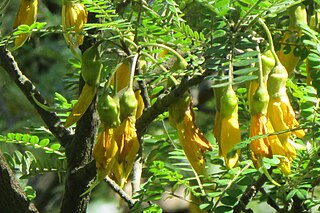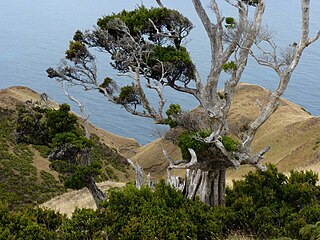
Myrceugenia is a genus of evergreen woody flowering trees and shrubs belonging to the myrtle family, Myrtaceae, first described as a genus in 1855. The genus is native to South America from central Brazil to southern Chile. It is closely related to the genus Luma; some botanists include Myrceugenia in that genus.

Sophora fernandeziana is a species of flowering plant in the legume family, Fabaceae, that is endemic to the Juan Fernández Islands of Chile. It is threatened by habitat loss.
Thorius munificus is a species of salamander in the family Plethodontidae. It is endemic to Mexico and only known from near its type locality near Las Vigas, Veracruz. Its natural habitats are pine-oak and pine forests, woodlands, and Arbutus forests with abundant shrubby and ericaceous plants. The species is threatened by habitat loss caused by logging, agriculture, and human settlement.
Campomanesia hirsuta is a species of plant in the family Myrtaceae. The plant is endemic to the Atlantic Forest ecoregion of southeastern Brazil, within Rio de Janeiro state. It is an IUCN Red List Endangered species, threatened by habitat loss.
Ficus lapathifolia is a species of plant in the family Moraceae. It is endemic to Mexico.
Melicope saint-johnii, the St. John's pelea or St. John's melicope, is a species of tree in the family Rutaceae. It is endemic to the Hawaiian Islands, where it is present only on the island of Oahu. Like other Hawaiian Melicope, this species is known as alani. It is threatened by habitat loss. It is a federally listed endangered species of the United States.
Myrceugenia bracteosa is a species of plant in the family Myrtaceae. It is endemic to Brazil.
Myrceugenia brevipedicellata is a species of plant in the family Myrtaceae. It is endemic to Brazil.
Myrceugenia campestris is a species of plant in the family Myrtaceae. It is endemic to Brazil.
Myrceugenia franciscensis is a species of plant in the family Myrtaceae. It is endemic to Brazil.
Myrceugenia kleinii is a species of plant in the family Myrtaceae.
Myrceugenia miersiana is a species of plant in the family Myrtaceae. It is endemic to Brazil.
Myrceugenia myrcioides is a species of plant in the family Myrtaceae. It is endemic to Brazil.
Myrceugenia pilotantha is a species of plant in the family Myrtaceae.
Myrceugenia rufescens is a species of plant in the family Myrtaceae. It is endemic to Brazil.

Myrceugenia schulzei is a species of plant in the family Myrtaceae. It is endemic to Alejandro Selkirk Island, of the Juan Fernández Islands archipelago in the Pacific Ocean, territory of the Republic of Chile. It is threatened by habitat loss.
Myrceugenia scutellata is a species of plant in the family Myrtaceae.

Protea comptonii, also known as saddleback sugarbush, is a smallish tree of the genus Protea in the family Proteaceae. It is found in South Africa and Eswatini.

Trichilia triacantha, the bariaco, is a species of plant in the Meliaceae family. It is endemic to Puerto Rico. It is threatened by habitat loss. It is a federally listed endangered species of the United States.
Vepris trifoliolata is a species of plant in the family Rutaceae. It is endemic to Cameroon. Its natural habitats are subtropical or tropical moist lowland forests and subtropical or tropical moist montane forests. It is threatened by habitat loss.





